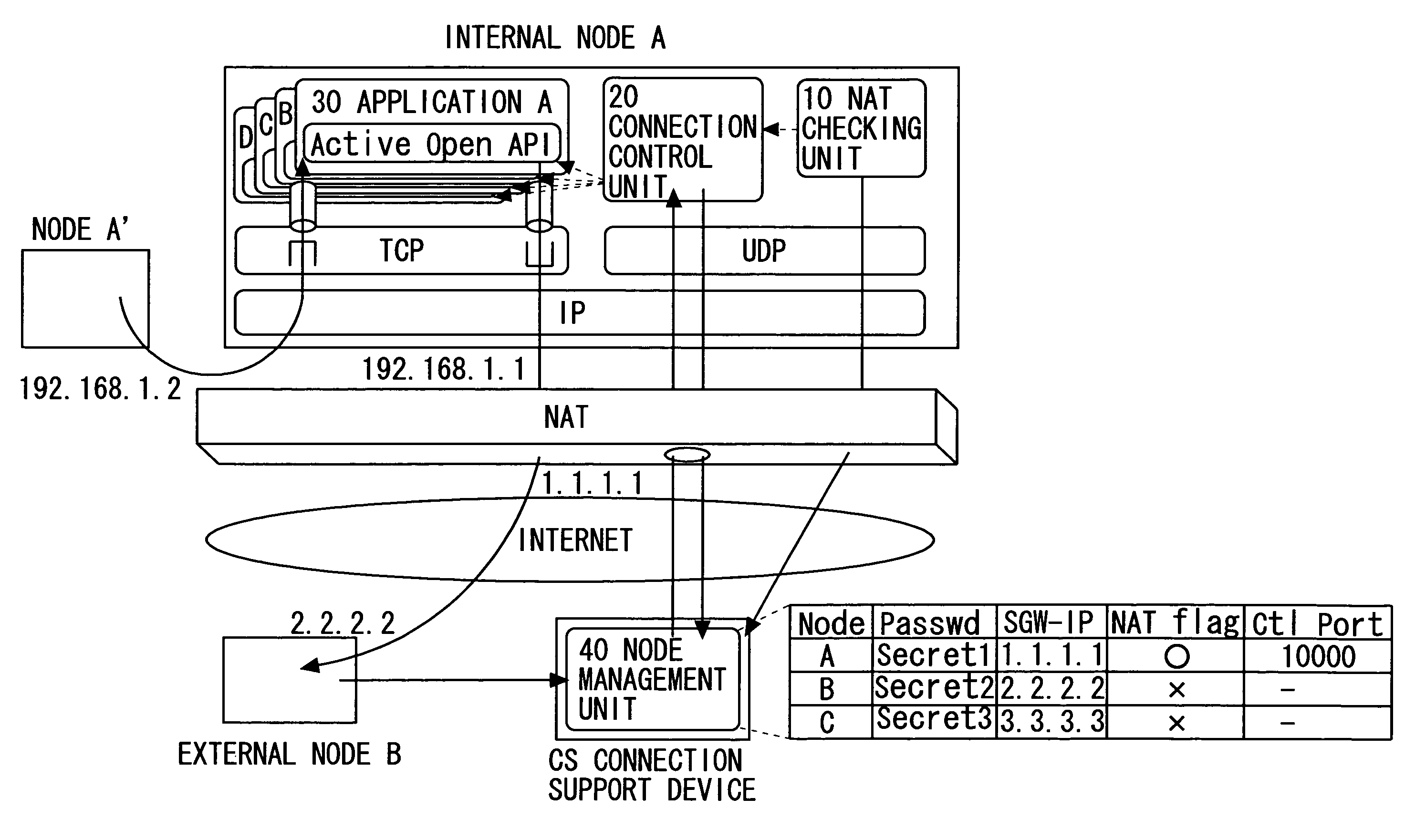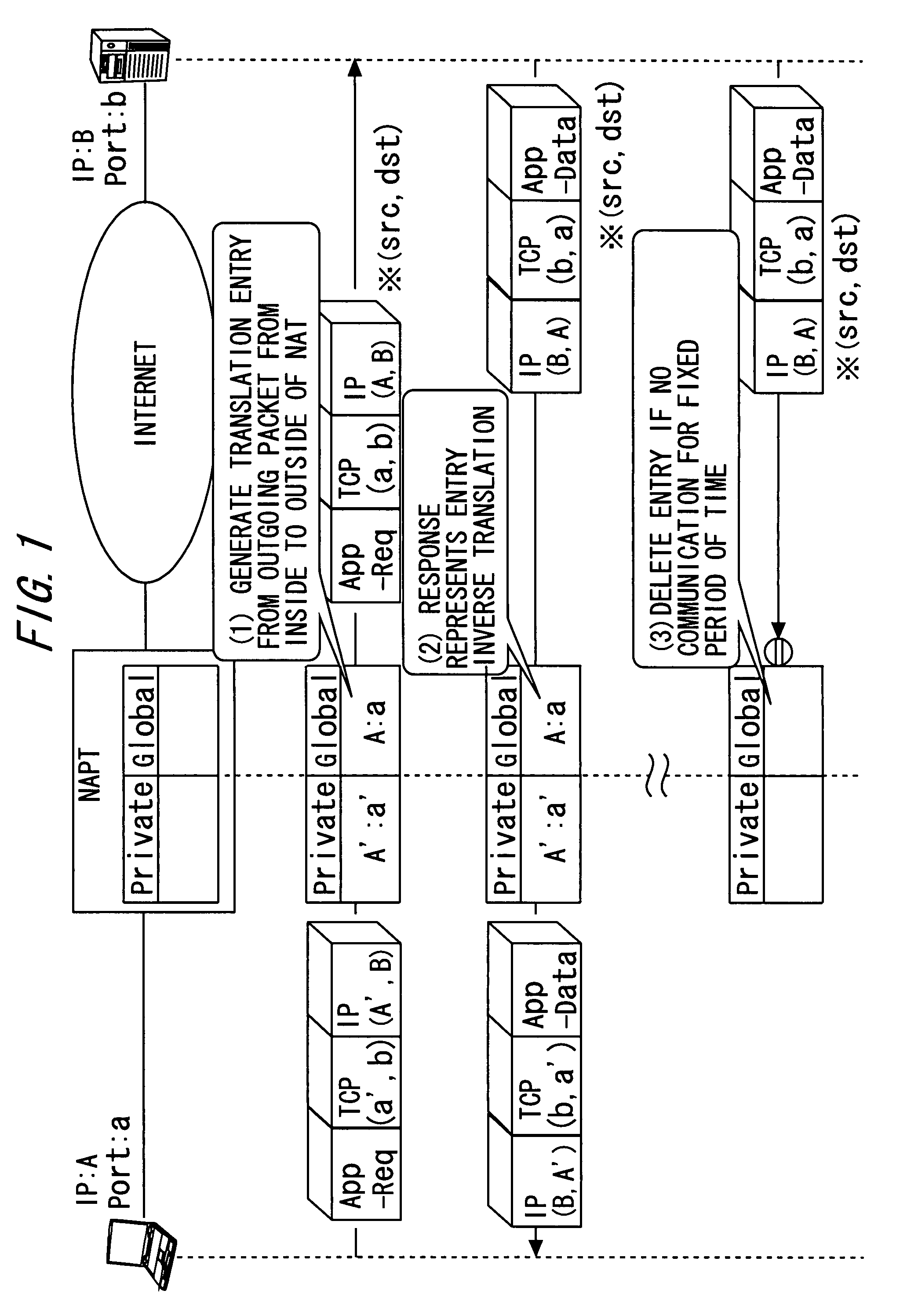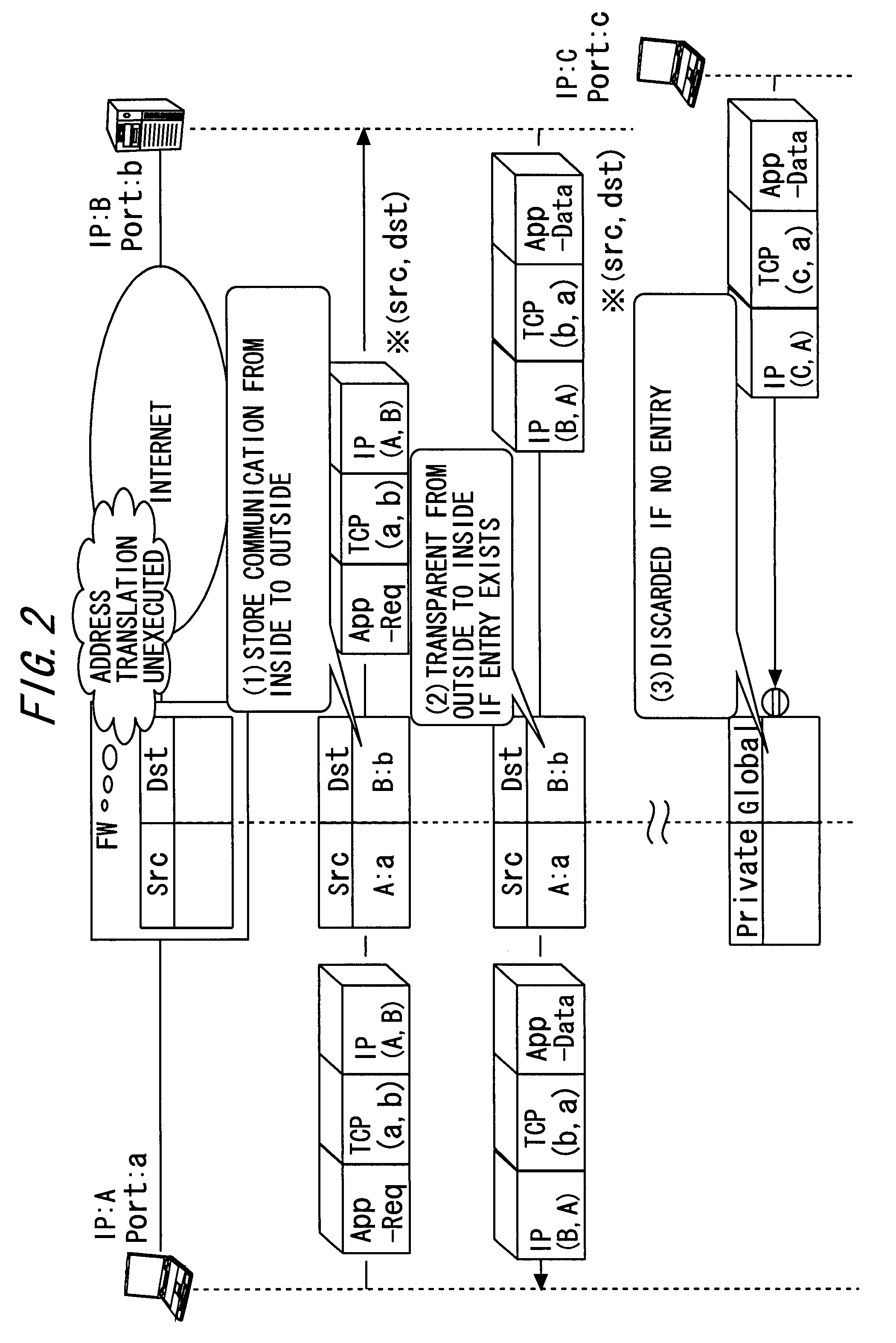IP application service providing system
a technology of application service and application server, applied in the field of ip (internet protocol) application service providing system, can solve the problems of application operation itself being required to be rearranged, packets not reaching, and second web server cannot be provided at default port no.80, so as to achieve the effect of convenient provision
Inactive Publication Date: 2010-04-27
FUJITSU LTD
View PDF12 Cites 14 Cited by
- Summary
- Abstract
- Description
- Claims
- Application Information
AI Technical Summary
Benefits of technology
The present invention provides a technology that allows for easy provision of IP application services without being aware of the presence or absence of a gateway device. The technology involves periodically transmitting a control packet to a connection support device on the outside network, notifying it of the control channel port and maintaining a communication permission entry of a control channel path. The internal node then receives notification of a connecting destination address / port pair associated with the external node via the control channel, and actively opens a data channel of the IP application to the notified destination address / port pair. This technology allows for seamless communication between the internal and external networks through the gateway device, regardless of its type or timing.
Problems solved by technology
Thus, the NAT / FW is effective in outside trigger communication (outbound communication) from the inside but, in inside trigger communication (inbound communication) from the outside, has no entry permitting the inbound communication with the result that a packet does not reach a node and therefore encounters with a big obstacle in the case of operating a server application and a P2P (Peer-to-Peer) application on the nodes subordinated to the NAT / FW (see FIG. 3).
There arise, however, the following problems inherent in these conventional technologies.
The conventional technology (2) requires support of the same protocol for both of the node and the NAT, and, if the node and the NAT are not within the same segment (namely, if the NATs are multi-staged and if a router is situated on a route up to the NAT), an UPnP packet (a multicast packet) is unable to reach the NAT, resulting in being uncontrollable.
Further, all of the conventional technologies emphasize how the inbound communication toward the inside is started from the outside of the NAT / FW, there is consequently a case of being unable to perform the communications at an arbitrary timing (namely, the connection can not be established unless synchronizing with action from under the NAT), and, in the case of scheming to operate a server application provided at a well-known port, a port conflict (where a plurality of applications can be provided at the same global port because of being unable to share the global port) occurs between the nodes and the applications.
For example, even when trying to configure two Web servers under the NAT, the second Web server cannot be provided at a default port No.80.
Thus, as compared with the case of having no existence of the NAT / FW, there is a large restraint on providing the applications, and, as the case may be, such a problem arises that the application operations themselves are required to be rearranged due to the existence of the NAT / FW.
Method used
the structure of the environmentally friendly knitted fabric provided by the present invention; figure 2 Flow chart of the yarn wrapping machine for environmentally friendly knitted fabrics and storage devices; image 3 Is the parameter map of the yarn covering machine
View moreImage
Smart Image Click on the blue labels to locate them in the text.
Smart ImageViewing Examples
Examples
Experimental program
Comparison scheme
Effect test
modified example
[0097]The processes in one embodiment discussed above are provided as a program executable by a computer and can be also provided through a storage medium such as a CD-ROM and a flexible disc and further via a communication line.
[0098]Moreover, the respective processes in one embodiment discussed above can be also carried out in a way that selects and combines an arbitrary plurality of or all of the processes.
the structure of the environmentally friendly knitted fabric provided by the present invention; figure 2 Flow chart of the yarn wrapping machine for environmentally friendly knitted fabrics and storage devices; image 3 Is the parameter map of the yarn covering machine
Login to View More PUM
 Login to View More
Login to View More Abstract
An IP application service providing method enabling inbound communication in IP application communication intended between an internal node concealed from an outside network and belonging to an inside network and an external node belonging to the outside network through a gateway device set to permit only outbound communication, includes periodically transmitting a control packet aiming at notifying of a control channel port and at maintaining a communication permission entry of a control channel path to a connection support device on the outside network from the internal node subordinated to the gateway device; notifying the internal node of a connecting destination address / port pair associated with the external node via the control channel from the connection support device; and actively opening a data channel of an IP application to the notified connecting destination address / port pair.
Description
BACKGROUND OF THE INVENTION[0001]The present invention relates generally to an IP (Internet Protocol) application service providing system, and more particularly to a connection support technology enabling a node, connected to an IP network such as the Internet, to easily perform IP application communication without depending on an existence / non-existence state of NAT / FW via a gateway device such as a network address translation (or translator) or a firewall (NAT / FW).[0002]In an IPv4 network, the network address translation (NAT) is widely employed in terms of saving global IP addresses. The NAT, especially a device called NAPT (Network Address Port Translation), translates a private address and a source port of an in-office / home network into a global address and a source port according to the NAPT (a NAPT table) (see FIG. 1), thereby enabling accesses to an outside network ONW from a plurality of internal nodes A.[0003]Further, in an IPv6 network, though an address starvation probl...
Claims
the structure of the environmentally friendly knitted fabric provided by the present invention; figure 2 Flow chart of the yarn wrapping machine for environmentally friendly knitted fabrics and storage devices; image 3 Is the parameter map of the yarn covering machine
Login to View More Application Information
Patent Timeline
 Login to View More
Login to View More Patent Type & Authority Patents(United States)
IPC IPC(8): H04L12/66G06F13/00H04L12/70
CPCH04L29/12367H04L29/12377H04L29/12509H04L61/2578H04L61/2514H04L61/2517H04L61/2567H04L29/12537
Inventor KITADA, ATSUSHI
Owner FUJITSU LTD
Features
- R&D
- Intellectual Property
- Life Sciences
- Materials
- Tech Scout
Why Patsnap Eureka
- Unparalleled Data Quality
- Higher Quality Content
- 60% Fewer Hallucinations
Social media
Patsnap Eureka Blog
Learn More Browse by: Latest US Patents, China's latest patents, Technical Efficacy Thesaurus, Application Domain, Technology Topic, Popular Technical Reports.
© 2025 PatSnap. All rights reserved.Legal|Privacy policy|Modern Slavery Act Transparency Statement|Sitemap|About US| Contact US: help@patsnap.com



